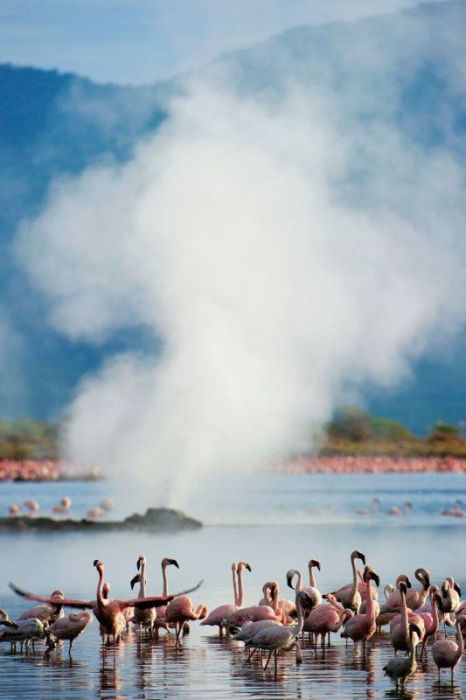|
|
Pink Blanket Of Flamingos, Rift Valley Lakes, Nakuru Lake National Park, Kenya
|
Flamingos filter-feed on brine shrimp and blue-green algae. Their oddly shaped beaks are specially adapted to separate mud and silt from the food they eat, and are uniquely used upside-down. The filtering of food items is assisted by hairy structures called lamellae which line the mandibles, and the large rough-surfaced tongue. The pink or reddish color of flamingos comes from carotenoid proteins in their diet of animal and plant plankton. These proteins are broken down into pigments by liver enzymes. The source of this varies by species, and affects the saturation of color. Flamingos whose sole diet is blue-green algae are darker in color compared to those who get it second hand (e.g. from animals that have digested blue-green aglae). Zoo-fed flamingos, who often lack the color enhancer in their diet, may be given food with the additive canthaxanthin.
Lifecycle
Flamingos are very social birds that live in colonies that can number in the thousands. These large colonies are believed to serve three purposes for the flamingos; predator avoidance, maximizing food intake and exploiting scarce suitable nesting sites. The most basic and stable social unit of flamingos are pair bonds which are made up of one male and one female. The bond between them tends to be strong, however in larger colonies, where there are more mates to choose from, mate changes will occur. In pair bonds, both the male and the female contribute to building the nest for their egg and defending it. Before breeding, flamingo colonies split into breeding groups of around 15-50 birds. Both males and females in these groups perform synchronized ritual displays. These displays serve to both stimulate synchronous nesting and establish pair formation for birds that do not already have mates. A flamingo group stands together and display to each other by rasing neck, followed by calling with head-flagging and then wing flapping. The displays do not seem to be directed towards an individual but instead occur randomly.
|
|









